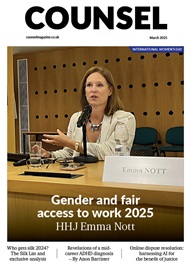*/
RARELY, in my experience, is a talk is so gripping and helpful that you wish it was longer. A packed Inner Temple Hall was treated to such a talk by Jonathan Sumption QC on 29 September 2009. His subject was Appellate Advocacy.
Throughout the talk he delighted the 300-strong audience with quips such as “Appellate judges are bigger than you and they hunt in packs”. These mild digs at the judges reminded everyone that this speaker was not a judge but a practising barrister like them. Jonathan shared some instructive insights into the judicial mind based on his experience. He said that judges had become less reverent of authority than in the past and that they cited fewer cases in their judgments these days. There was now a tendency to set out broad principles of law exemplified by the authorities across a range of subjects rather than applying authorities directly to the case being decided. He also noted and welcomed an increasing willingness by judges to consider the social and economic implications of their decisions in their judgments.
Starting with the premise that “Judges start with an instinctive view and work backwards to justify it”, Jonathan made some practical suggestions for skeleton arguments and oral advocacy. Here are five out of a much longer list that will be at the forefront of my mind when I appear in the Court of Appeal:
Perhaps the best question was “What can you do about the difficult judge?”. To this JS said “You can’t force him to listen, you can only hope he makes a real mess of the judgment. It is good to lose as comprehensively and unfairly as possible to make it easier in the Court of Appeal”. Alas, that such this excellent advice should be of such small comfort in civil work – with permission to appeal nearly always required, the judge rarely giving it and the costs of seeking permission from the Court of Appeal so high, the difficult judge may well escape his come-uppance.
Starting with the premise that “Judges start with an instinctive view and work backwards to justify it”, Jonathan made some practical suggestions for skeleton arguments and oral advocacy. Here are five out of a much longer list that will be at the forefront of my mind when I appear in the Court of Appeal:
Perhaps the best question was “What can you do about the difficult judge?”. To this JS said “You can’t force him to listen, you can only hope he makes a real mess of the judgment. It is good to lose as comprehensively and unfairly as possible to make it easier in the Court of Appeal”. Alas, that such this excellent advice should be of such small comfort in civil work – with permission to appeal nearly always required, the judge rarely giving it and the costs of seeking permission from the Court of Appeal so high, the difficult judge may well escape his come-uppance.
RARELY, in my experience, is a talk is so gripping and helpful that you wish it was longer. A packed Inner Temple Hall was treated to such a talk by Jonathan Sumption QC on 29 September 2009. His subject was Appellate Advocacy.
Throughout the talk he delighted the 300-strong audience with quips such as “Appellate judges are bigger than you and they hunt in packs”. These mild digs at the judges reminded everyone that this speaker was not a judge but a practising barrister like them. Jonathan shared some instructive insights into the judicial mind based on his experience. He said that judges had become less reverent of authority than in the past and that they cited fewer cases in their judgments these days. There was now a tendency to set out broad principles of law exemplified by the authorities across a range of subjects rather than applying authorities directly to the case being decided. He also noted and welcomed an increasing willingness by judges to consider the social and economic implications of their decisions in their judgments.


Efforts continue on gender equality, support for the Bar, meaningful reform for the sector and advocating for the rule of law
To mark International Women’s Day, Louise Crush of Westgate Wealth Management looks at how financial planning can help bridge the gap
Casey Randall of AlphaBiolabs answers some of the most common questions regarding relationship DNA testing for court
Leading drug, alcohol and DNA testing laboratory AlphaBiolabs has made a £500 donation to Beatson Cancer Charity in Glasgow as part of its Giving Back campaign
Girls Human Rights Festival 2025: a global gathering for change
Exclusive Q&A with Henry Dannell
Patrick Green KC talks about the landmark Post Office Group litigation and his driving principles for life and practice. Interview by Anthony Inglese CB
Desiree Artesi meets Malcolm Bishop KC, the Lord Chief Justice of Tonga, who talks about his new role in the South Pacific and reflects on his career
Sir Nicholas Mostyn, former High Court judge, on starting a hit podcast with fellow ‘Parkies’ after the shock of his diagnosis
Exclusive QA with Henry Dannell
Once you submit your silk application, what happens next? Sir Paul Morgan explains each stage of the process and reflects on his experience as a member of the KC Selection Panel